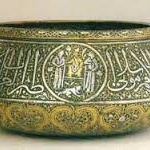Quran calligraphy in carpet and metalworking in Safavid period

Research in the field of traditional Iranian art , in addition to identifying the technical and artistic aspects of the culture and history of this land, reveals cultural and historical aspects of the period for the researchers
Research in the field of traditional Iranian art , in addition to identifying the technical and artistic aspects of the culture and history of this land, reveals cultural and historical aspects of the period for the researchers.
It is obvious that access to these aspects, is easier when these works are decorated by calligraphy and gives useful data.
Traditional art works in different periods, specially after the advent of Islamic rich culture in Iran, with respect to emphasizing of this religion on science and literacy and its positive approach in order to benefit calligraphy art , have benefited calligraphy a lot.
Of course, the usage of calligraphy did not have only decorative aspect, but it was used in order to show the position of the issue. Safavid period is one of the most glorious periods of traditional art. Two arts of carpet and metalworking are important arts of this period.
In this article, in order to identify the position of calligraphy in metal works and carpets, samples of metal works and carpets having calligraphy including Quran, such as 7 carpets and 9 metal works, have been surveyed. The survey is from the content aspect and the review of calligraphy art in composition. The relation between these two arts and their usages , have been studied .
The status of these two arts of Safavid period, have been studied before. Most of the carpets which are decorated by Qurani verses, are endowment carpets or mats or decorative ones which would not be touched without ablution. Therefore, the carpets decorated by calligraphy, are small rugs. Those metal works which are decorated by Quran verses, had special usage and were generally used for ritual and religious aims. The contents of Quranic verses is determined by practical significance of verses. Therefore, the artist has used smaller chapters of 30th component of Quran which includes Ayat-Al-Korsi and short verses containing messages.
The method of subjects gathering for this article is library method and its arrangement is done relying on documents and descriptive-analytical and comparative method.
Main Questions:
1.What are the Quranic contents latent in carpets and metal works calligraphies in Safavid period?
2. has the usage of Quranic contents in carpet and metal works been effective on the type of its usage?
Main Targets:
1.Recognition of contents types used in carpets and metal works in Safavid period,
2.Achieving to distinction and similarity of Quranic calligraphies used in carpets and metal works in Safavid period.
It is obvious that access to these aspects, is easier when these works are decorated by calligraphy and gives useful data.
Traditional art works in different periods, specially after the advent of Islamic rich culture in Iran, with respect to emphasizing of this religion on science and literacy and its positive approach in order to benefit calligraphy art , have benefited calligraphy a lot.
Of course, the usage of calligraphy did not have only decorative aspect, but it was used in order to show the position of the issue. Safavid period is one of the most glorious periods of traditional art. Two arts of carpet and metalworking are important arts of this period.
In this article, in order to identify the position of calligraphy in metal works and carpets, samples of metal works and carpets having calligraphy including Quran, such as 7 carpets and 9 metal works, have been surveyed. The survey is from the content aspect and the review of calligraphy art in composition. The relation between these two arts and their usages , have been studied .
The status of these two arts of Safavid period, have been studied before. Most of the carpets which are decorated by Qurani verses, are endowment carpets or mats or decorative ones which would not be touched without ablution. Therefore, the carpets decorated by calligraphy, are small rugs. Those metal works which are decorated by Quran verses, had special usage and were generally used for ritual and religious aims. The contents of Quranic verses is determined by practical significance of verses. Therefore, the artist has used smaller chapters of 30th component of Quran which includes Ayat-Al-Korsi and short verses containing messages.
The method of subjects gathering for this article is library method and its arrangement is done relying on documents and descriptive-analytical and comparative method.
Main Questions:
1.What are the Quranic contents latent in carpets and metal works calligraphies in Safavid period?
2. has the usage of Quranic contents in carpet and metal works been effective on the type of its usage?
Main Targets:
1.Recognition of contents types used in carpets and metal works in Safavid period,
2.Achieving to distinction and similarity of Quranic calligraphies used in carpets and metal works in Safavid period.
+
2015-05-09 03:05